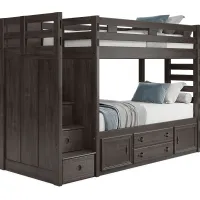Bunk Beds & Loft Beds
489 Results

Rooms To Go
Kids Creekside 2.0 Charcoal Twin/Twin Step Bunk Bed with Storage Side Rail






Rooms To Go
Kids Camp Hideaway White Twin Jr. Loft Bed with Pink Tent and Slide

Rooms To Go
Kids Daintree White Twin Jr. Loft Bed with Drawers and Slide

Rooms To Go
Kids Canyon Lake Ash Gray Twin/Full Step Loft with Desk



Rooms To Go
Kids Creekside 2.0 Charcoal Full/Full Step Loft with Loft Chest and Bookcase


Rooms To Go
Kids Creekside 2.0 Chestnut Twin Loft with Loft Chest and Desk Attachment

Raymour & Flanigan
Premium Twin over Full Metal Bed in Blue by DOREL HOME FURNISHINGS


Raymour & Flanigan
Carissa Bunk Bed with Storage Staircase in Natural by Homelegance

Rooms To Go
Kids Cottage Colors White Twin/Full Loft Bunk Bed with Dresser



Rooms To Go
Kids Canyon Lake Ash Gray Twin/Twin Loft with Desk

Rooms To Go
Kids Creekside 2.0 Chestnut Full/Full Bunk Bed with Storage Side Rail







Raymour & Flanigan
Jordan Full-Over-Full Bunk Bed in Gray by Hillsdale Furniture

Rooms To Go
Kids Creekside 2.0 Charcoal Twin Loft with Loft Desk, Chest and Desk Attachment

Rooms To Go
Kids Creekside 2.0 Charcoal Twin/Twin Loft with 2 Loft Chests



Raymour & Flanigan
Silver Screen Twin over Futon Bunk Bed in Silver by DOREL HOME FURNISHINGS

Rooms To Go
Kids Cottage Colors White Twin/Twin Loft Bunk Bed with Dresser





Rooms To Go
Disney Frozen White Twin Loft Bed with Activity Panel, Tower, Tent and Slide

Raymour & Flanigan
Art Play Junior Low Loft Bed in Brown by Donco Trading






The Bunk Beds & Loft Beds Guide
Whether you’re looking for a fun way to bring on bedtime delight or clever ways to maximize space in a child’s bedroom, consider a bunk or loft bed solution. A stacked sleeping arrangement brings personality into a room’s design, as well as an efficient storage solution for toys, crafts, or clothing.
Bunk beds can be configured in a variety of sizes and heights to create a safe environment for kids as they grow and develop. Infuse creativity and functionality to promote curiosity and play during the day and restful sleep at night.
Bunk vs Loft Bed
Before you embark on the journey to find the perfect bookcase or shelf, consider the following factors.
Bunk vs Loft Bed
One of the main perks with bunk beds is the ability to customize the setup to meet your needs. Here are some popular options.
Read the full guide
F.A.Q.
What is the minimum ceiling height for bunk beds?
Ceiling height is crucial when deciding whether to install bunk beds in a room. A standard bunk bed’s minimum ceiling height for comfort and safety is eight feet.
At this height, you’ll find enough headroom above the top bunk to ensure both beds are safe and comfortable, allowing easy access to and from the bed. Of course, remember to measure the height of the mattress and bunk bed itself. For example, if you opt for beds with extra-tall legs, you might need nine-foot or higher ceilings.
What age group are bunk beds for?
Bunk beds are typically designed for children six years or older.
Bunk beds are popular in homes with multiple kids, as these beds can maximize space and provide additional storage options. It’s common for younger siblings to share a room before they hit their teens, so bunk beds can also make bedtime more fun and are terrific for sleepovers.
Sturdier bunk bed designs are also available for teenagers and adults, especially those sharing dorm rooms or smaller living arrangements.
Do bunk beds save space?
Yes! Most bunk beds are designed specifically for efficiency to make the most of smaller spaces. Stacking two beds on top of each other frees up floor space to move around, play, or place other furniture.
Many modern bunk beds also come with additional features, such as drawers, built-in storage cubbies, and desks. Some even have unique designs that allow you to convert the bed into a sofa or study space. These add to their space-saving qualities, making bunk beds an essential furniture choice in shared, compact living spaces.
